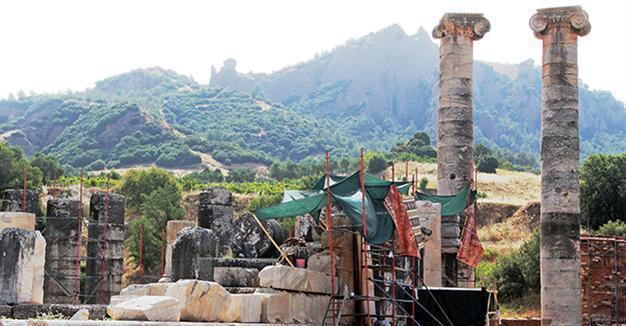Historic columns of Sardis in for cleaning
MANİSA – Anadolu Agency

AA photo
Columns that one graced Sardis, the capital of the ancient Lydian Kingdom, are getting a clean and polish to bring them back to their original state.
Work is continuing in the ancient city of Sardis in the western province of Manisa, where many structures still survive, to unearth a 13-meter arch and streets. Parts of the columns that have lost their original color are being cleaned with special chemicals.
The head of the excavations, Professor Nicholas Dunlop, said the 2016 excavation season recently started in Sardis.
He said the excavations were first initiated in Sardis in 1854, continuing with semi-regularity before finally gaining academic status in 1958. The 5,000-year-old ancient city bears the traces of the Persian, Hellenistic, Greek, Roman and Byzantine cultures, as well as the Lydian Kingdom.
“So far, only 3 percent of the ancient city has been unearthed,” Dunlop said.
A five-year working program has been prepared for the Temple of Artemis, which is ne of the best preserved structures in the ancient city, as well as the bath, Dunlop said.
“Cleaning work has started in the temple as well as in the tarnished parts of the other structures in the city. They are affected by weather conditions and moisture. In order to bring back their original color, we are focusing on the cleaning stage. Women are cleaning columns and marbles with specially prepared chemicals using sensitive brushes,” he said.
Main entrance to city to be revealed
Dunlop said they had entered the second year of the excavations at the entrance part of the city. “We are working in the parts dating from the Roman and Lydian eras,” he said. “We are trying to completely unearth the main gate and streets of the city.”
The city’s 13-meter-wide arch was fairly large compared to similar ancient cities, said Dunlop.
“During excavations, we surprisingly found the ruins of a monumental Roman-era arch. We think that the blocks on the ground belong to this arch. The widest arch that we have unearthed so far was 9.7 meters. As far as I understand, this is the widest arch, at 13 meters.”
5,000-year-old settlement
Situated in the area of Sart in Manisa’s Salihli district, Sardis was home to many civilizations between the seventh century B.C. and the early Byzantine era.
The capital of the Lydian Kingdom in the ancient age, the city is known as the place where money was printed for the first time in history. Sardis became a rich city thanks to agriculture, stockbreeding, trade and gold mining.
Sardis was also one of Seven Churches of Revelation that played an important role in the growth of Christianity, while artifacts that have been unearthed there are now displayed at the Manisa Museum.
